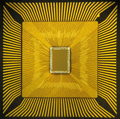IBM has chips manufactured working with artificial neurons. The chips were developed in the context of research into the simulation of neurons and the development of computers that function in a similar way as the brain.
The two prototypes that IBM researchers as part of this project, developed to brain to emulate in their operation. Parts of neurons are not software simulated, but in the hardware built. The chips contain, respectively, 262.144 programmable to 65,536 learning synapses, and each chip has 256 neurons on board. The neurons have the math to do, while the synapses as a memory to serve, and communication by ‘axons’ must be realized.
The 45nm produced, simple chips are just the forefront of what IBM has in mind. The company wants chips to build ten billion artificial neurons and a hundred trillion synapses. That computer system would be but a thousand watts may be deprived, and not much larger than two cartons of milk. Such a system would have information of a large number of sensors need to collect, and then real-time processing. Traditional chips are bad, but a brain-based system that would be thanks to parallelization very well.
The prototypes are already relatively simple tasks, such as navigation and machine vision’ accomplish. With the money from Darpa must be a team including the universities of Columbia, Cornell, California, and Wisconsin to work on the Synapse project to develop further.
